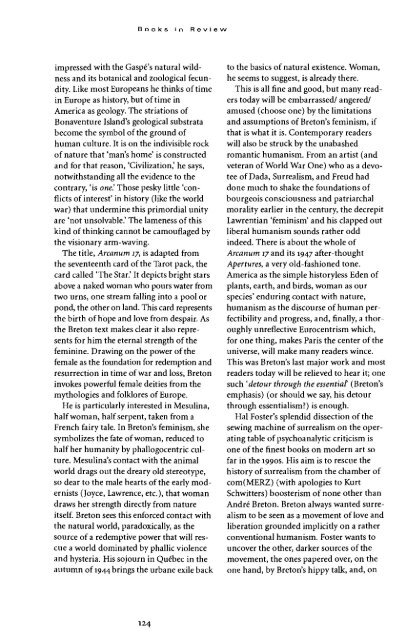Jean Rivard - University of British Columbia
Jean Rivard - University of British Columbia
Jean Rivard - University of British Columbia
You also want an ePaper? Increase the reach of your titles
YUMPU automatically turns print PDFs into web optimized ePapers that Google loves.
Books in Review<br />
impressed with the Gaspé's natural wildness<br />
and its botanical and zoological fecundity.<br />
Like most Europeans he thinks <strong>of</strong> time<br />
in Europe as history, but <strong>of</strong> time in<br />
America as geology. The striations <strong>of</strong><br />
Bonaventure Island's geological substrata<br />
become the symbol <strong>of</strong> the ground <strong>of</strong><br />
human culture. It is on the indivisible rock<br />
<strong>of</strong> nature that 'man's home' is constructed<br />
and for that reason, 'Civilization,' he says,<br />
notwithstanding all the evidence to the<br />
contrary, 'is one! Those pesky little 'conflicts<br />
<strong>of</strong> interest' in history (like the world<br />
war) that undermine this primordial unity<br />
are 'not unsolvable.' The lameness <strong>of</strong> this<br />
kind <strong>of</strong> thinking cannot be camouflaged by<br />
the visionary arm-waving.<br />
The title, Arcanum 1/, is adapted from<br />
the seventeenth card <strong>of</strong> the Tarot pack, the<br />
card called 'The Star.' It depicts bright stars<br />
above a naked woman who pours water from<br />
two urns, one stream falling into a pool or<br />
pond, the other on land. This card represents<br />
the birth <strong>of</strong> hope and love from despair. As<br />
the Breton text makes clear it also represents<br />
for him the eternal strength <strong>of</strong> the<br />
feminine. Drawing on the power <strong>of</strong> the<br />
female as the foundation for redemption and<br />
resurrection in time <strong>of</strong> war and loss, Breton<br />
invokes powerful female deities from the<br />
mythologies and folklores <strong>of</strong> Europe.<br />
He is particularly interested in Mesulina,<br />
half woman, half serpent, taken from a<br />
French fairy tale. In Breton's feminism, she<br />
symbolizes the fate <strong>of</strong> woman, reduced to<br />
half her humanity by phallogocentric culture.<br />
Mesulina's contact with the animal<br />
world drags out the dreary old stereotype,<br />
so dear to the male hearts <strong>of</strong> the early modernists<br />
(Joyce, Lawrence, etc.), that woman<br />
draws her strength directly from nature<br />
itself. Breton sees this enforced contact with<br />
the natural world, paradoxically, as the<br />
source <strong>of</strong> a redemptive power that will rescue<br />
a world dominated by phallic violence<br />
and hysteria. His sojourn in Québec in the<br />
autumn <strong>of</strong> 1944 brings the urbane exile back<br />
to the basics <strong>of</strong> natural existence. Woman,<br />
he seems to suggest, is already there.<br />
This is all fine and good, but many readers<br />
today will be embarrassed/ angered/<br />
amused (choose one) by the limitations<br />
and assumptions <strong>of</strong> Breton's feminism, if<br />
that is what it is. Contemporary readers<br />
will also be struck by the unabashed<br />
romantic humanism. From an artist (and<br />
veteran <strong>of</strong> World War One) who as a devotee<br />
<strong>of</strong> Dada, Surrealism, and Freud had<br />
done much to shake the foundations <strong>of</strong><br />
bourgeois consciousness and patriarchal<br />
morality earlier in the century, the decrepit<br />
Lawrentian 'feminism' and his clapped out<br />
liberal humanism sounds rather odd<br />
indeed. There is about the whole <strong>of</strong><br />
Arcanum 17 and its 1947 after-thought<br />
Apertures, a very old-fashioned tone.<br />
America as the simple historyless Eden <strong>of</strong><br />
plants, earth, and birds, woman as our<br />
species' enduring contact with nature,<br />
humanism as the discourse <strong>of</strong> human perfectibility<br />
and progress, and, finally, a thoroughly<br />
unreflective Eurocentrism which,<br />
for one thing, makes Paris the center <strong>of</strong> the<br />
universe, will make many readers wince.<br />
This was Breton's last major work and most<br />
readers today will be relieved to hear it; one<br />
such 'detour through the essential (Breton's<br />
emphasis) (or should we say, his detour<br />
through essentialism?) is enough.<br />
Hal Foster's splendid dissection <strong>of</strong> the<br />
sewing machine <strong>of</strong> surrealism on the operating<br />
table <strong>of</strong> psychoanalytic criticism is<br />
one <strong>of</strong> the finest books on modern art so<br />
far in the 1990s. His aim is to rescue the<br />
history <strong>of</strong> surrealism from the chamber <strong>of</strong><br />
com(MERZ) (with apologies to Kurt<br />
Schwitters) boosterism <strong>of</strong> none other than<br />
André Breton. Breton always wanted surrealism<br />
to be seen as a movement <strong>of</strong> love and<br />
liberation grounded implicitly on a rather<br />
conventional humanism. Foster wants to<br />
uncover the other, darker sources <strong>of</strong> the<br />
movement, the ones papered over, on the<br />
one hand, by Breton's hippy talk, and, on<br />
124

















